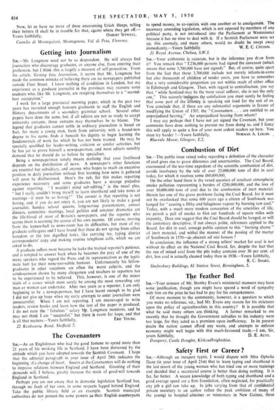Combustion of Dirt S1R,—The public issue raised today regarding a
definition of the character of coal gives rise to grave dilemmas and uncertainties. The Coal Board, enamoured of the war-time expedient of the scientific combustion of dirt, avoids insolvency by the sale of over 25,000,000 tons of dirt in coal today, for which it receives some £60,000,000.
On the other hand there is the vexed question of resultant atmospheric smoke pollution representing a burden of £200,000,000, and the loss of over 10,000.000- tons of coal due to the combustion of inert material. Herein lies one of the grave problems facing the Coal Board, for it must not be overlooked that some 600 years ago a citizen of Southwark was hanged for " causing a filthy and fuluginous vapour by burning raw coal." Today, with a- much more modern conception of the amenities of life, we permit a pall of smoke to blot out hundreds of square miles with impunity. Dare one suggest that the Coal Board should be hanged, or will the customary descriptive, if not always polite, references applied to the Board, for dirt in coal, assuage public opinion to this " burning shame " of inert material, and withal the manner of the passing of the martyr of Southwark in 1370—de,nlartuis nil nisi bonum ?
In conclusion, the influence of a strong sellers' market for coal is not without its effect on the National Coal Board, for, despite the fact that the run of mined coal from the pits today contains over 30 per cent. of dirt, less coal is actually-cleaned today than in 1938.—Yours faithfully, R. C. SMART.
Shaftesbury Buildings, 61 Station Street, Birmingham, 5.






































 Previous page
Previous page